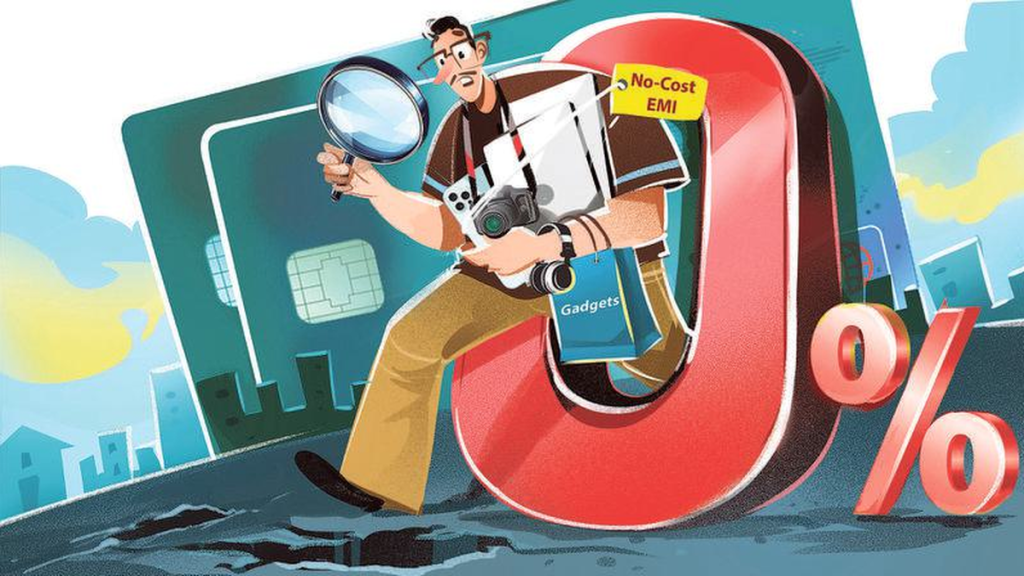No-cost EMI is one of the most popular financing options for high-ticket consumer durables such as gadgets and home appliances. It allows consumers to defer high-value purchases over several monthly instalments without any additional interest charges. Popular e-complatforms such as Amazon, Flipkart, Ajio, TataCLiQ and more offer the no-cost EMI facility in collaboration with leading card issuers. But is it truly as beneficial as it seems? Let’s take a closer look at the benefits of no-cost EMIs and some key factors to consider when opting for it.
How it works?
Unlike regular EMI transactions that come with additional interest charges, no-cost EMI allows you to divide the cost of a product into monthly instalments without any interest. The interest is still factored into the EMI, but merchants or lenders offset it by providing an equivalent discount.
Here is an example. Suppose you are buying a refrigerator worth ₹60,000 using credit card EMI for a tenure of six months. If the card issuer charges an interest rate of 16% on EMIs, the total interest charged will be ₹9,600, along with 18% GST on the interest component, amounting to ₹1,728. In a regular EMI plan, you have to pay the product price and the interest amount along with GST, which means your total outgo would be ₹71,328.
However, in the case of no-cost EMI, the interest amount is adjusted as a discount, allowing you to get the product at its actual price. In the above example, the merchant would offer an upfront discount of ₹9,600, which will cover your interest cost, effectively reducing your EMI amount to ₹10,000 per month. This means, you would be paying only actual price of the product, that is ₹60,000.
However, a key factor to consider is while the merchant provides an upfront discount to offset the interest cost, the GST on the interest amount is still payable by the cardholder. In the above example, GST of ₹1,728 will be charged to your credit card. Note that, GST will also be applicable on processing fee and other applicable charges.
While no-cost EMIs can be a reasonable choice for high-value purchases, here are some key factors to consider before choosing this option.
Choose tenure wisely
Unlike regular EMIs, no-cost EMIs generally have shorter repayment tenures, typically ranging from 3-9 months. A shorter tenure would increase EMI amount, hence it is important to choose the tenure strategically. You must ensure the EMI amount fits your monthly budget and you can comfortably pay your dues on time without financial burden..
Read fine print
While the term “no-cost” sounds appealing, many lenders charge processing fee on no-cost EMIs, which increases the overall cost of the product. Although you get the product at its actual price with a No-Cost EMI, the additional charges can add to the cost. Similarly, some lenders slap pre-payment penalties. So, if you anticipate that you would have funds to pay the amount earlier, you must check the associated terms. Also, note 18% GST will be applicable on the interest, processing fee and other applicable charges, which you would need to pay out of pocket.
Loss of rewards
Most credit cards exclude EMI transactions from rewards and cashback programmes. So, despite charging a high-value transaction to your card, you would not get any benefits. For instance, if you buy an item worth ₹50,000 on EMI from Amazon using a credit card that offers 5% cashback on online spends, you would miss earning ₹2,500 cashback.
Merchants offer no-cost EMI in collaboration with card issuers like SBI Card, HDFC Bank, ICICI Bank,, Axis Bank and others. Generally, the offer applies to all cards issued by the respective providers. However, in some cases, no-cost EMI may be applicable only on select credit card variants. Hence, it is crucial to check if your card is eligible.
Timely payment
In addition to these key factors, you must ensure paying the EMIs as and when due to avoid finance charges and late payment penalties. Moreover, when you purchase a product on EMI, your credit limit is blocked for the entire transaction amount and gradually released as you pay, which can increase your credit utilisation ratio initially. This could be a concern for individuals with a single credit card with low credit limit, as a high CUR may impact credit score.
Opting for Should you opt for no-cost EMIs?
No-cost EMIs are quite helpful for individuals who need to make necessary high-ticket purchases like gadgets, consumer durables, etc. but cannot afford upfront payment. They provide them with the flexibility to buy purchase the products and defer the payment over several months, without disrupting their cash flow.
However, additional costs like processing fees, the impact on your credit limit and potential penalties must be carefully considered before opting for a no-cost EMI. Always weigh benefits against potential pitfalls before proceeding.
(The writer is chief business officer, credit cards, Paisabazaar.com)
Published – April 14, 2025 05:05 am IST


